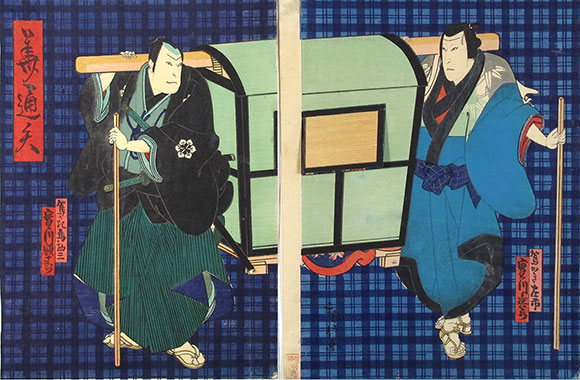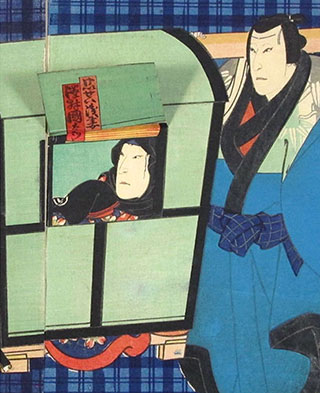

Ashinoya Hironobu (芦野家廣信)Ashinoya Hironobu (芦野家廣信 act. c. 1851-1872), whose surname was Kinoshita (木下), used at least six different art pseudonyms. He was a pupil of Konishi Hirosada (小西廣貞) and worked nearly exclusively as a designer of actor prints (yakusha-e: 役者絵) in the chûban format, the overwhelmingly dominant print size in Kamigata (Kyoto-Osaka region) after the relaxation of shogunate regulations called the Tenpô kaikaku (Tenpô reforms: 天保改革), in effect from 6/1842 to 1/1847. Hironobu also designed kyôga (playful or comic pictures: 狂画) and e'iri nehon (Illustrated playbooks: 絵入根本).
In the 1860s, there was a limited renaissance of ôban-format printmaking in Osaka, particularly for deluxe sets of ôkubi-e ("large head" prints: 大首絵). Hironobu participated in designing a few prints for one such series titled Hana kurabe nishiki utsushie (A true comparison of brocade flowers [actors]: 華競錦写絵), a grouping to which the artist Ichiyôsai Yoshitaki (一養齋芳瀧) also contributed. The set of portraits was first issued as jôzuri-e ("top quality prints" or deluxe edition: 上摺絵) and then afterwards as namizuri-e (ordinary prints or standard edition: 並摺絵) without the use of metallics. One of these ôban designs by Hironobu is shown above, a deluxe-edition portrayal of Arashi Tokusaburô IV (嵐徳三郎) as Hangakujo (半がく女) in the play Wada gassen onna maizuru (The battles of Wada and the female dancing crane: 和田合戦女舞鶴) in 5/1865 at the Takeda Theater, Osaka. The printer-publisher for this design affixed his hand-stamped seal in the lower left margin, reading suri-shi ("master printer") Horikame (摺師堀亀). Horikame was a master printer who likely distributed the design and thus acted as a publisher. Despite the rather late date for this design in the ukiyo-e tradition, it compares favorably with the finest deluxe pre-Tenpô kaikaku kamigata-e. It is characterized by superb block carving and printing, including extensive shômen-zuri (burnishing: 正面摺) throughout and a bronze metallic pattern on the inner blue robe, preserved here on a very large sheet with exceptionally wide margins. The actor featured in Hironobu's deluxe design, Arashi Tokusaburô IV, was later called Arashi Rikan IV (嵐里環, 1837-94). He was considered a first-rate kaneru yakusha ("all-around actor": 兼ねる役者) with a beautiful voice (his delivery was said to be pitch-perfect). Porforming both in Kamigata and in Edo/Tokyo, he excelled in jidaimono (history plays: 時代物).
Less than a year after Hironobu's contributions to the series Hana kurabe nishiki utsushie discussed above, he produced one of the rarities in Osaka prinmaking — a shikake ("loose flap": 仕掛) composition featuring a hinged flap that when lifted revealed an alternate view of the design. Although found occasionally in Edo printmaking, shikake are virtually unknown in kamigata-e. The images below show the diptych with the flap down and a detail with the flap up.
In this example, the courtesan Asatsuma is seated inside a kago ("vehicle basket" or palanquin: 駕籠 or simply 駕) with the blinds drawn. Only when the flap is raised (see image at right) can she be seen, along with the actor and role name in red cartouches. "Keisei" translates roughly as "castle toppler," a courtesan among the highest ranks, although the term was not used to designate a particular grade of prostitute. The main part of the play title (hana no tôriya, 華通矢) is given in the large red cartouche at the top of the left sheet. The publisher's seal for Horikame appears in the lower left margin on each sheet. Backgrounds with "plaid" patterns were especially popular in kamigata-e during the 1860s-70s, a reflection of the increasingly innovative textile weaving techniques in the region. A view of the back of the print reveals how the printers added the figure of Asatsuma by gluing down a small piece of paper with her image over a cut-out area under the flap. See my text and image at Hironobu, shikake. for a detail view of the reverse side. ©1999-2021 by John Fiorillo BIBLIOGRAPHY
|
Viewing Japanese Prints |


 Hironobu's diptych portrays (R) Jitsukawa Enjaku I (実川延若) as kagokaki (palanquin bearer) Saichi (駕かき左市) / Sawamura Kunitarô III (沢村國太朗) as keisei (courtesan) Asatsuma (けいせい浅妻), and (L) Jitsukawa Gakujûrô II (実川額十郎) as kagokaki (palanquin bearer) Ukanza (駕かき烏勘三). The play was produced in 1/1866 as Keisei hana no tôriya (possibly translating as "A courtesan and a connoisseur's oath": けいせい華通矢) at the Naka Theater, Osaka.
Hironobu's diptych portrays (R) Jitsukawa Enjaku I (実川延若) as kagokaki (palanquin bearer) Saichi (駕かき左市) / Sawamura Kunitarô III (沢村國太朗) as keisei (courtesan) Asatsuma (けいせい浅妻), and (L) Jitsukawa Gakujûrô II (実川額十郎) as kagokaki (palanquin bearer) Ukanza (駕かき烏勘三). The play was produced in 1/1866 as Keisei hana no tôriya (possibly translating as "A courtesan and a connoisseur's oath": けいせい華通矢) at the Naka Theater, Osaka.